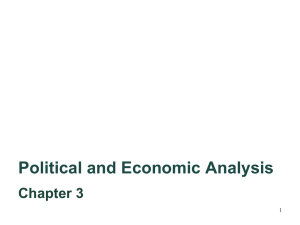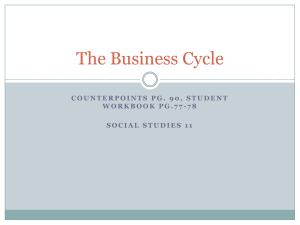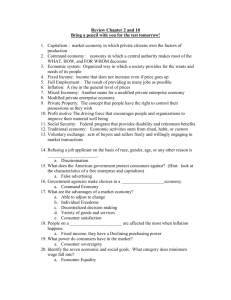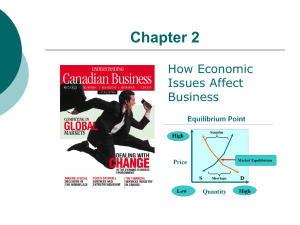The Economy
advertisement
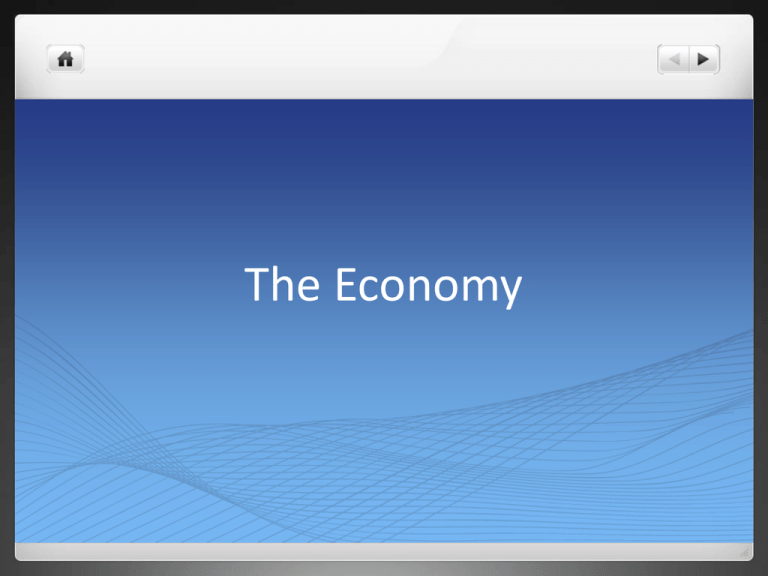
The Economy What is an economy? Economics - the social science that analyzes the production, distribution, and consumption of goods and services. Ultimately, it is how money is produced, wealth is achieved, and how objects are bought and sold. Production – the ability to makes products, also known as goods. Distribution – the ability to trade or sell goods Goods – products that can be bought and sold Services – The ability to provide a service for a client Types of Economies There are three types of economies 1) Capitalism 2) Mixed Economies 3) Socialism Capitalism (Free Market Economy) Capitalism - is an economic system in which trade, industry, and the means of production are privately owned and operated via profit and loss. All businesses are privately owned The success of the business is based on making profits Relies on a market system – the rule of “Supply and Demand” If markets are good, business is good, if markets are down business is bad Business is good = employment opportunities, business is bad = no employment opportunities. Government should NOT INTERVENE Capitalism (Free Market Economy) Pros Cons • You can make a lot of money • Very susceptible to the demands of the market place • Businesses is where the real power and • Regulary in flux via the boom bust cycle control is within a society • Chance for a lot of employment • Employees are and can be treated like slaves • Profits are more important than employees Supply and Demand Supply and Demand – there are two parts to this rule A) if the supply of a products goes up the price of goods goes down and vice versa. B) if the demand for a product goes up the price goes up and vice versa Supply & Demand Supply $ Price $ Supply $ Price $ Demand $ Price $ Demand $ Price $ Communism (Command Economy) An economic system in which the state or the community owns all property and the means of production, and all citizens share the wealth equally. Creates, theoretically, a classless society – i.e. no upper, middle or lower classes. Communism (Command Economy) Pros Cons • Everyone has equal opportunity for wealth redistribution • People who do not pull their own weight will be rewarded equally to those who work hard • Government, instead of select individuals, looking out for the public • Government sets the rules and regulations to the point that it can infringe on private citizens • Employees are the most important to society, not profits • Opportunity for growth is dependent upon government needs, not individual desire – i.e. stymies research and growth Socialism (Mixed Economy) Mixed Economy - refers to market economies with strong regulatory oversight and governmental provision of public goods with some state-run enterprises (businesses). It is a mix between communism and capitalism The idea is to allow capitalism all the while have strong regulations to protect the workers – ex. minimum wage, age restrictions for workers, fair labour practices, Keynesian Economics, and etc… Government can also own businesses, usually businesses that are for the public good – like BC Hydro, Potash Corp, CBC, and etc…. The goal is to find a balance between 100% government ownership and the volatility of capitalism. Capitalism (Market economy) Ownership and Individuals control control means of production Competition Standard of Living Socialism (mixed economy) Basic means of production owned and managed by government Communism (Command economy) Government owns means of production Market determines what goods will be sold at Private ownership, with what price regulation, of businesses Government determines what goods will be sold at what price Competition keeps prices low and quality high Cooperation stressed over competition No competition, lower quality goods High standard of living and economic security High standard of living and economic security Individuals free to earn profits, but may risk losses Goal is equality for everybody, enforced by the government High taxes provide free health care and education What does Canada have? We have a mixed economy Key terms that affect and have an impact on our economy Gross Domestic Product (GDP), Boom Bust Cycle, Unemployment Rates, Inflation and; Cost of Living Increases (CPI) Government Intervention Gross Domestic Product (GDP) Our economy is successful if we have a strong Gross Domestic Product GDP measures the output of all labor and capital within the Canadian geographical boundary. If we have a high GDP that means we are doing well economically. If we have a negative GDP we have entered a recession and could be in a depression. Boom Bust Cycle A process of economic expansion and contraction that occurs repeatedly in our economy. It is based on the GDP of a country. During the boom the economy grows, jobs are plentiful and the market brings high returns to investors. In the subsequent bust the economy shrinks, people lose their jobs and investors lose money. Boom-bust cycles last for varying lengths of time; they also vary in severity. Boom Bust Cycle Boom Bust Cycle Unemployment Rates The percentage of the total labor force that is unemployed but actively seeking employment and willing to work. Canada - 6.5% United States – 5.3% Russia – 5.5% Germany – 4.5% Norway – 4.3% China – 4.1% Finland – 9.7% Sweden – 7.2% France – 10.7% Laos – 2.5% Inflation Inflation - is the rate at which the general level of prices for goods and services is rising. consequently the purchasing power of employees is falling if they do not get a raise at the rate of inflation. Central banks attempt to limit inflation, and avoid deflation, in order to keep the economy running smoothly. 2014 – 1.47%, 2013 – 1.24%, 2012 - .83%, 2011 – 2.3%, 2010 – 2.35%, 2009 – 1.32%, 2008 – 1.16%, 2007 – 2.38%, Cost of Living & Consumer Price Index Cost of Living is based on the Consumer Price Index (CPI) The CPI is the percentage increase in the cost of products sold within a geographic location (nation). It would be best for employees to get raises that are at or greater than the CPI. That way their purchasing power does not decrease. Purchasing power is the ability to purchase an object every year and the amount of money in your pocket never decreases. Government Intervention In a mixed economy, governments intervene in two ways: 1) Setting regulations around employment, the economy, and businesses 2) Creating a public enterprise (business) Government Regulations 1. Government ensures 1) that capitalism doesn’t run freely at the detriment of workers and 2) businesses do not let profits usurp the health and safety of the worker. Some regulations include minimum wage, work hours, child labour laws, tax laws, workplace health and safety laws and etc… Government Regulations 2. 3. Economic regulations are ones that are created to protect us so that food that we get from other countries do not harm us or cause potential harm Example - hormone induced milk, non-mad cow diseased meat, canned goods and raw foods that are free of dangerous pesticides. Downside is the price of these goods are a little more expensive, but the benefit is we get healthier food. Governments have programs where they can infuse money into the economy to help it get out of a recession – example welfare state. Public Enterprises 1. Governments create businesses in areas that the private sector tends to avoid, but is needed – example B.C. Hydro 2. Governments also create businesses in areas that the private sector is not doing well in – Potash Corp and SaskTel (both from Saskatchewan). 3. Governments create businesses as a way to create employment to keep unemployment down and to set up a system where citizens can make money that they can spend in an economy to keep the economy healthy. Why is this important? ALL OF THESE ECONOMIC THEORIES, TERMS and ETC… affect your ability to be employed, income sustainability, budget flexibility, and the ability to make ends meet in this world. 1. Gross Domestic Product (GDP) – low GDP = lower chances to find a job, or higher chances of being laid off. 2. Boom Bust Cycle – During the boom you have a chance to be employed (low unemployment), during the bust you have a chance of being unemployed (high unemployment) 3. Unemployment Rates – Helps establish a countries work force. High unemployment rates = low productivity and low productivity = recession or depression = no business investment. Why is this important? 4. Inflation - identifies the rise in the cost of goods and services. It helps establish the economic growth, or decline, in a country and affects your income and purchasing power. 5. Cost of Living Increases (CPI) – identifies what you should be asking for with respect to raises within your job. It helps ensure that your purchasing power does not decrease, and if it does, it helps you adjust your budget. 6. Government Intervention – helps protect employees from businesses, ensures opportunity for economic growth and during recessions helps stimulate the economy to create jobs. They also create regulations to protect its citizens and its workers. Ultimately, the government we elect have a profound impact on our economy and as such have a HUGE IMPACT on you as a worker/citizen in Canada.


